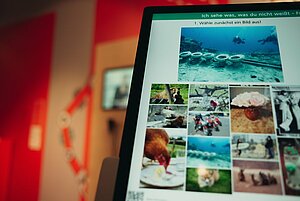November 14, 2019
With 85,000 visitors in the logbook, the exhibition ship MS Science finished its tour through 31 cities between Berlin and Vienna. In the "Science Year 2019 - Artificial Intelligence", the exhibition on board the inland cargo ship revolved around learning computer systems. More than 500 school classes, many families and interested people of all ages were on board and informed themselves about how Artificial Intelligence (AI) learns and functions as well as in which areas of life it is applied. On deck, the discussion revolved around ethical implications, social impacts and artistic aspects of Artificial Intelligence. The Fraunhofer Heinrich Hertz Institute HHI showed its demo "Visual Question Answering - A look into the black box of neural networks" on board the floating Science Center from May to October 2019.
Why Artificial Intelligence comes to a certain assessment is often not revealed. For us, its decision-making processes take place invisibly in neuronal networks. Researchers at Fraunhofer HHI now want to increase their exploration of this black box in order to make AI decisions comprehensible. In the image evaluation procedure used here, the AI marks the areas of the image that were decisive for its decision. It also indicates how certain or likely it considers its answer to be. Thus, the results become transparent and can also be reviewed by experts. This process can be used in many areas, for example in medicine and in autonomous vehicles. "This so-called 'explainable AI' does not only bring many practical advantages, but also allows a simpler exposure of AI cheat candidates," explains Wojciech Samek, Group Leader of Machine Learning in the Department of Video Coding and Analytics at Fraunhofer HHI. The demo is still on display in the CINIQ Center/Forum Digital Technologies at the Fraunhofer HHI.
As every year, the interactive exhibits on MS Science came directly from current research: Institutes of the Fraunhofer-Gesellschaft, Helmholtz Association, Leibniz Association, Max Planck Society and DFG-funded projects, universities and other partners have contributed exhibits. The Austrian Federal Ministry of Education, Science and Research as well as the government of Lower Austria and Upper Austrian Research GmbH made the stay in Austria possible.
More Information can be found in the Press Release (German only) by wissenschaft im dialog.
